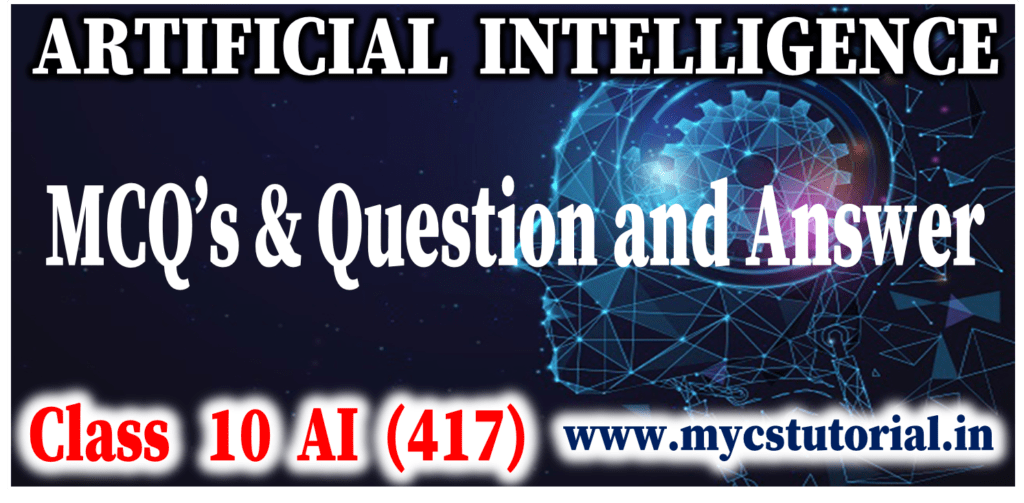By Anjeev Kr Singh – Computer Science Educator
Published on : September 19, 2022 | Updated on : February 9, 2023
3. Draw the 4Ws problem canvas and explain each one of them briefly.
Answer: The 4Ws problem canvas is the basic template while scoping a problem and using this canvas, the picture becomes clearer while we are working to solve it.
a) Who: The “Who” block helps you in analyzing the people getting affected directly or indirectly due to it? Under this, you find out who the ‘stakeholders’ to this problem are and what you know about them. Stakeholders are the people who face this problem and would be benefitted with the solution.
b) What: Under the “What” block, you need to look into what you have on hand. At this stage, you need to determine the nature of the problem. What is the problem and how do you know that it is a problem?
c) Where: In this block, you need to focus on the context/situation/location of the problem. It will help you look into the situation in which the problem arises, the context of it, and the locations where it is prominent.
d) Why: in the “Why” canvas, think about the benefits which the stakeholders would get from the solution and how would it benefit them as well as the society.
4. Differentiate between rule-based and learning-based AI modelling approaches.
Answer: Rule Based Approach:
It refers to the AI modelling where the relationship or patterns in data are defined by the developer. The machine follows the rules or instructions mentioned by the developer, and performs its task accordingly.
For example, suppose you have a dataset comprising of 100 images of apples and 100 images of bananas. To train your machine, you feed this data into the machine and label each image as either apple or banana. Now if you test the machine with the image of an apple, it will compare the image with the trained data and according to the labels of trained images, it will identify the test image as an apple. This is known as Rule based approach. The rules given to the machine in this example are the labels given to the machine for each image in the training dataset.
Learning Based Approach: In this approach, the machine learns by itself. It refers to the AI modelling where the relationship or patterns in data are not definedby the developer. In this approach, random data is fed to the machine and it is left on the machine to figure out patterns and trends out of it. Generally, this approach is followed when the data is un labelled and too random for a human to make sense out of it.
For example, suppose you have a dataset of 1000 images of random stray dogs of your area. You would put this into a learning approach-based AI machine and the machine would come up with various patterns it has observed in the features of these 1000 images which you might not have even thought of!
5. What is an Artificial Neural Network? Explain the layers in an artificial neural network.
Answer: Artificial Neural Network: Modeled in accordance with the human brain, a Neural Network was built to mimic the functionality of a human brain. The human brain is a neural network made up of multiple neurons, similarly, an Artificial Neural Network (ANN) is made up of multiple perceptrons.
A neural network consists of three important layers:
Input Layer: As the name suggests, this layer accepts all the inputs provided by the programmer.
Hidden Layer: Between the input and the output layer is a set of layers known as Hidden layers. In this layer, computations are performed which result in the output. There can be any number of hidden layers
Output Layer: The inputs go through a series of transformations via the hidden layer which finally results in the output that is delivered via this layer.
6. What is the need of an AI Project Cycle? Explain.
Answer: Project cycle is the process of planning, organizing, coordinating, and finally developing a project effectively throughout its phases, from planning through execution then completion and review to achieve pre-defined objectives.
Our mind makes up plans for every task which we have to accomplish which is why things become clearer in our mind. Similarly, if we have to develop an AI project, the AI Project Cycle provides us with an appropriate framework which can lead us towards the goal.
The major role of AI Project Cycle is to distribute the development of AI project in various stages so that the development becomes easier, clearly understandable and the steps / stages should become more specific to efficiently get the best possible output. It mainly has 5 ordered stages which distribute the entire development in specific and clear steps: These are Problem Scoping, Data Acquisition, Data Exploration, Modelling and Evaluation.
7. Explain the following:
a. Supervised Learning b. Unsupervised Learning
Answer:
(a) Supervised learning is an approach to creating artificial intelligence (AI), where the program is given labelled input data and the expected output results.
OR
Supervised learning is a learning in which we teach or train the machine using data which is well labelled that means some data is already tagged with the correct answer. After that, the machine is provided with a new set of examples (data) so that supervised learning algorithm analyses the training data (set of training examples) and produces a correct outcome from labelled data.
OR
In a supervised learning model, the dataset which is fed to the machine is labelled. It means some data is already tagged with the correct answer. In other words, we can say that the dataset is known to the person who is training the machine only then he/she is able to label the data.
(b) Unsupervised Learning: An unsupervised learning model works on unlabeled dataset. This means that the data which is fed to the machine is random and there is a possibility that the person who is training the model does not have any information regarding it. The unsupervised learning models are used to identify relationships, patterns and trends out of the data which is fed into it. It helps the user in understanding what the data is about and what are the major features identified by the machine in it.
OR
Unsupervised learning is the training of a machine using information that is neither classified nor labelled and allowing the algorithm to act on that information without guidance. Here the task of the machine is to group unsorted information according to similarities, patterns and differences without any prior training of data.
8. Differentiate between classification and clustering algorithms with the help of suitable examples.
Answer: Classification is a process of finding a function which helps in dividing the dataset into classes based on different parameters. In Classification, a computer program is trained on the training dataset and based on that training; it categorizes the data into different classes. The task of the classification algorithm is to find the mapping function to map the input(x) to the discrete output(y).
Example: The best example to understand the Classification problem is Email Spam Detection. The model is trained on the basis of millions of emails on different parameters, and whenever it receives a new email, it identifies whether the email is spam or not. If the email is spam, then it is moved to the Spam folder.
Regression is a process of finding the correlations between dependent and independent variables. It helps in predicting the continuous variables such as prediction of Market Trends, prediction of House prices, etc. The task of the Regression algorithm is to find the mapping function to map the input variable(x) to the continuous output variable(y).
Example: Suppose we want to do weather forecasting, so for this, we will use the Regression algorithm. In weather prediction, the model is trained on the past data, and once the training is completed, it can easily predict the weather for future days.
OR
Classification is the process of finding or discovering a model (function) which helps in separating the data into multiple categorical classes. In classification, the group membership of the problem is identified, which means the data is categorized under different labels according to some parameters and then the labels are predicted for the data.
Regression is the process of finding a model or function for distinguishing the data into continuous real values instead of using classes. Mathematically, with a regression problem, one is trying to find the function approximation with the minimum error deviation. In regression, the data numeric dependency is predicted to distinguish it. The Regression analysis is the statistical model which is used to predict the numeric data instead of labels. It can also identify the distribution movement depending on the available data or historic data.
OR
Key Differences between Classification and Regression
• The Classification process models a function through which the data is predicted in discrete class labels. On the other hand, regression is the process of creating a model which predicts continuous quantity.
• The classification algorithms involve decision tree, logistic regression, etc. In contrast, regression tree (e.g. Random forest) and linear regression are the examples of regression algorithms.
• Classification predicts unordered data while regression predicts ordered data.
• Regression can be evaluated using root mean square error. On the contrary, classification is evaluated by measuring accuracy.

9. Five sustainable Development Goals are mentioned below. Write 2 problems under each goal that you think should be addressed for achieving the goal.
- a. Quality Education
- b. Reduced Inequalities
- c. Life on Land
- d. No Poverty
- e. Clean Water and Sanitation
Answer:
a. Quality Education:
i. Providing education remotely, leveraging hi-tech, low-tech and no-tech approaches;
ii. Ensure coordinated responses and avoid overlapping efforts;
iii. Ensuring return of students to school when they reopen to avoid an upsurge in dropout rates.
b. Reduced inequalities:
i. Reduction of relative economic inequalities inequality in some countries having poorest and most vulnerable communities.
ii. Improving the situations in countries with weaker health systems.
c. Life on Land:
i. Prevention of Deforestation caused by humans and restoration of land
ii. Preventions and cure of diseases that are transmissible between animals and humans
d. No Poverty
i. Creation of Strong social protection systems to prevent people from falling into poverty
ii. Reduction of social exclusion, and high vulnerability of certain populations to disasters and diseases.
iii. Responsible distribution of resources.
e. Clean Water and Sanitation
i. To increase access to clean drinking water and sanitation mostly in rural areas
ii. Managing our water sustainably to manage our production of food and energy.
10. Do ethics in AI hamper data acquisition stage? Justify your answer.
Answer: Data acquisition is the most important factor or stage as the entire project development is based on the acquired data. There are several ethical issues which must always be considered when planning any type of data collection.
We need to understand that the data which is collected is ethical only if the provider agrees to provide. For example, in case of smartphone users, data is collected by clicking on allow when it asks for permission and by agreeing to all the terms and conditions. But at the same time if one does not want to share his/her data with anyone then this ethical issue hampers the acquisition process and lowers the accuracy or amount of data required for development.
Hence Regardless of the type of data collection, it is absolutely necessary to gain the approval of the community from which the data will collected otherwise.








